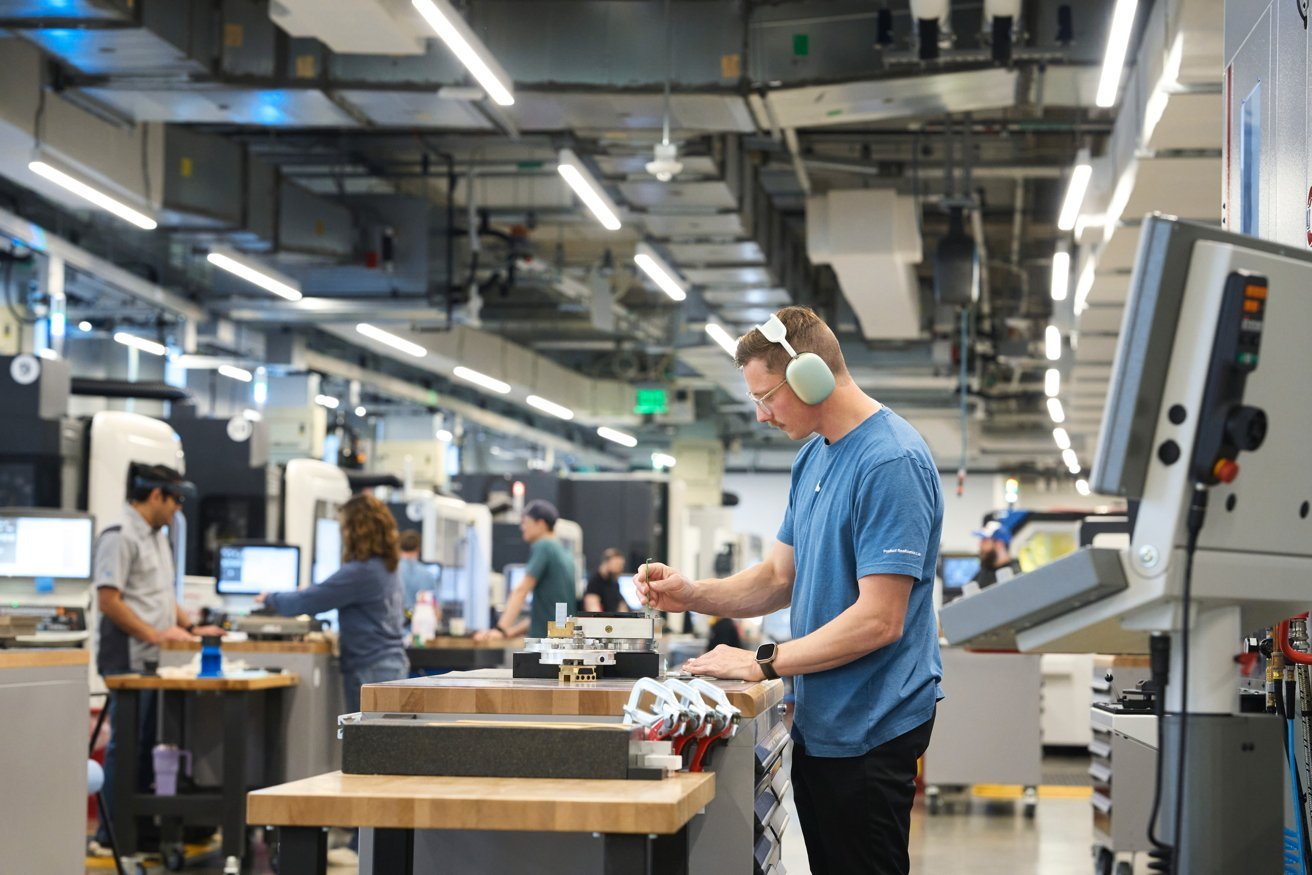President Trump believes iPhone manufacturing could shift to the US very quickly. He’s wrong — it won’t happen during his term, if it happens at all.
During a press briefing on Tuesday, White House Press Secretary Karoline Leavitt responded to a question about whether Trump believes iPhone production could ultimately move to the U.S. Apparently, President Trump thinks the United States has the resources and the workforce necessary for such an endeavor.
Leavitt said that Trump was looking to bring manufacturing jobs “back home” to the United States and that he was “looking at advanced technologies,” among other things:
The president wants to increase manufacturing jobs here in the United States of America, but he’s also looking at advanced technologies. He’s also looking at AI and emerging fields that are growing around the world that the United States needs to be a leader in as well. There’s an array of diverse jobs. More traditional manufacturing jobs, as you discussed, and also jobs in advanced technologies. The president is looking at all of those. He wants them to come back home.
The question referenced a recent statement by the U.S. Secretary of State Howard Lutnick, who said that “the army of millions and millions of people screwing in little, little screws to make iPhones” would be coming to America. Leavitt’s response indicates that President Trump agrees with Lutnick’s assessment.
The use of “screws” in this context is a gross over-simplification of iPhone assembly, which should be incredibly obvious to even the most casual observer. Multiple high-tech components, material suppliers, and manufacturers are also involved, as Apple sources finished components from the likes of Sony, LG, and, of course, TSMC for Apple Silicon chips.
In a follow-up question, Leavitt was asked specifically about iPhone production in the United States, and whether that type of technology could be brought over.
“Absolutely,” Leavitt remarked, adding that President Trump believes the U.S. has the necessary resources for iPhone manufacturing.
To support that claim, Leavitt said that Apple wouldn’t have invested $500 billion in the United States if they believed the country couldn’t handle iPhone assembly. In reality, the $500B U.S. investment referenced by Leavitt has very little to do with the iPhone, almost nothing to do overall with Apple hardware manufacturing, and isn’t anything out of the ordinary for Apple, as it is nearly all prior announcements.
These remarks are all made despite the United States not having a single iPhone assembly facility that takes four or more years to build, does not have inexpensive and skilled labor that can take decades to foster, has to import nearly all of rare earth materials to make an iPhone that will all be tariffed on their own, and there are no sub-assembly factories to use those raw materials necessary for iPhone component production.
In short, the entire supply chain for the iPhone doesn’t exist in the US. Most of it would have to be generated from scratch.
This will take at least five years without training a labor force. That may take an entire generation. It will certainly take longer than Trump’s term in office.
U.S. production of Apple chips is actually five years behind Taiwan
It’s not all lacking. There is one notable exception.
Some Apple chips are already made in Arizona, though they’re far from the latest and greatest technology. Apple partner TSMC began construction on its Arizona chip production facility back in 2020, and it took more than four years to begin manufacturing from the first ceremonial shovel-full of dirt to announcements that production has begun.
TSMC’s Arizona facility currently produces Apple’s A16 Bionic chip found in the standard iPhone 15. It also makes a SIP (system-in-package) for the Apple Watch, but both chips use the dated N4 four-nanometer production process.
A second TSMC facility is scheduled to be opened in 2027 or 2028, which might be used for the production of more modern 3nm chips. The iPhone 15 Pro, for instance, features a 3nm A17 Pro chip, as do devices that belong to the current iPhone 16 range, with the A18 line of system-on-chips.
A third TSMC factory, subsidized by the U.S with $6.6B, will reportedly produce 2nm chips by 2030. Currently, Apple is expected to include a 2nm A20 chip in the iPhone 18 Pro, which will likely reach end consumers in 2026. At that rate, it would effectively take TSMC four years to start producing a then-dated chip in the United States.
If true, this means that TSMC’s US manufacturing efforts are a whole five years behind its Taiwan operations, indicating that the latest Apple chips likely won’t be made in the United States for the foreseeable future. Probably close to a decade.
Under Taiwanese law, domestic chip manufacturers, such as TSMC, are allowed to produce chips elsewhere in the world. The catch is that they must be at least one generation behind fabrication facilities operated in Taiwan.
In November 2024, Taiwan Minister of Economic Affairs J. W. Kuo said that TSMC must keep producing chips using the latest production processes in its home country.
“Since Taiwan has related regulations to protect its own technologies, TSMC cannot produce 2-nanometer chips overseas currently,” Kuo said at the time. “Although TSMC plans to make 2-nanometer chips [abroad] in the future, its core technology will stay in Taiwan.”
This effectively means couldn’t produce the latest and greatest Apple chips in the United States, even if the company wanted to do so. Still, this is not the only reason why large-scale iPhone production isn’t feasible in the United States, as the devices require plenty of other components.
Made in USA iPhones are an unlikely scenario at best
Nearly 90% of iPhones are currently produced in China, mainly by Apple suppliers Foxconn and Luxshare, among others. Other countires, such as India, only account for about 10% to 15% of total iPhone production, and that’s typically been for good reason.

Apple has an R&D center in Austin, but large-scale manufacturing would be effectively impossible. Image Credit: Apple
The United States lacks cheap labor with the skillset suitable for iPhone manufacturing, which is, in contrast, readily available overseas. Foxconn and other suppliers also have existing facilities, with assembly lines that have produced Apple products for generations over multiple years. If Apple wanted to move large-scale iPhone production to the United States, it would effectively have to start from scratch.
In December 2022, Apple CEO Tim Cook said that the use of US-made A16 chips in Apple products was “only the beginning.” Cook explained that Apple was “investing in a stronger, brighter future, we are planting our seed in the Arizona desert.” Apple wanted to “nurture its growth,” but that growth ultimately took years.
TSMC’s Arizona facility alone took four years to complete, and that facility only produces a single component. Apple would need to source land and all sorts of raw materials and resources for its US manufacturing efforts. The United States also lacks finished goods. Some iPhone components, such as the device’s cameras, are sourced from companies such as Sony, and the same goes for the device displays.
Apple would still need to import all of these individual parts and core hardware components, as it is highly unlikely that an effective substitute would be found in a U.S.-based company or manufacturing facility. Even if one was found, this would still drive costs up, and consumers might not be willing to deal with increased prices.
Though President Trump believes iPhone manufacturing could return to the United States, the reality is that won’t happen anytime soon.

Apple reportedly wants to import more iPhones from India. Image Credit: Apple
Apple understandably wants to keep manufacturing costs low. To do so it needs to avoid Trump’s planned tariffs on goods produced in China and elsewhere.
That’s why Apple has reportedly been stock-piling current-generation products. It’s also why the company supposedly has plans to increase iPhone imports from India soon.
Not in the US. In India. That effort has been going on for years already.
India has a much lower 26% tariff compared to the staggering 104% Trump has planned for China. Still, many believe Apple will increase iPhone prices as a result, with one report predicting a 43% more expensive iPhone in September 2025.
Consumers are already panic-buying current-generation products, and that trend will likely continue until a solution is found. While unlikely, Apple may secure a tariff exemption again, as Apple CEO Tim Cook has a way of negotiating with President Trump.
In any case, moving manufacturing efforts to the United States wouldn’t solve any problems. Even if, through some miracle, Apple managed to source all components domestically, plants started up instantly, and a skilled workforce manifested magically, that would drive costs through the roof, and US consumers likely wouldn’t put up with it.


-xl.jpg?w=696&resize=696,0&ssl=1)